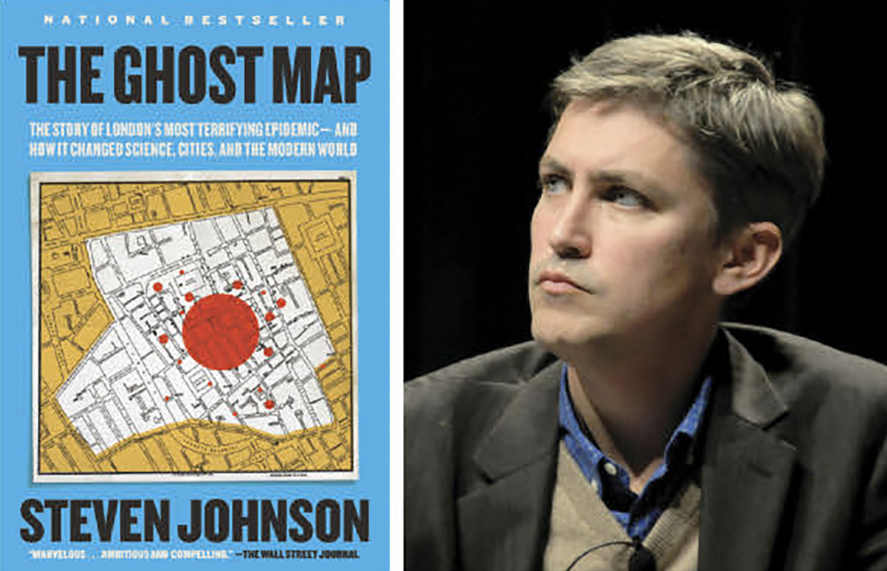Nursing Book Club
The Ghost Map by Steven Johnson
The Story of London’s Most Terrifying Epidemic — And How It Changed Science, Cities, and the Modern World

I’m sure that in a public health nursing class long ago, I heard the story of how removing the handle of the Broad Street pump ended London’s cholera epidemic of 1854. I’m just as sure that I didn’t give it another thought until I picked up this latest edition of Steven Johnson’s 2006 book about that same epidemic.
The Poisoned Well
All epidemics have a first case, known as an index case. The first recorded victim of this particular cholera epidemic, on Aug. 28, 1854, was the 6-month-old daughter of Sarah and Thomas Lewis, who lived at 40 Broad Street, near the Broad Street well. Within a period of only two weeks, nearly 700 more people had died. Most lived within 250 yards of the well.
Johnson explains in great detail how this could happen and why the London Board of Health was slow to recognize the problem and take action.
The prevailing theory of the time was that disease was linked to “miasma,” or bad air. Noxious odors were everywhere due to unsanitary conditions, so even though the sewers and the Thames River were filled with human waste, it wasn’t polluted water but polluted air that concerned health officials.
Johnson follows the progression of the disease across several households and recounts the arguments of the public health officers as they searched for the source of the epidemic. The doctors debated whether the upper class was spared because they lived in roomier accommodations, or whether people living on the ground floor were less likely to get the disease.
Investigators wrestled with questions like why there were some outlying cases blocks away, while some very crowded environments (like workhouses) had no cases at all.
Medical Detective Work
Three men become instrumental to ending the outbreak:
John Snow was a local epidemiologist with an interest in cholera who was intent on proving that the problem was contaminated drinking water.
William Farr was London’s registrar-general, who had recently thought to add “cause of death” to the statistics the city compiled.
Rev. Henry Whitehead was the pastor of St. Luke’s parish church, who made it a point to visit every family with a death or illness. Rather than merely offering platitudes, Whitehead began to question local residents about their activities and whereabouts on the days prior to becoming sick.
Snow then used this information to map the course of the illness, and eventually traced the epidemic back to the Broad Street well.
COVID Contact Tracing
This is how outbreak investigations are still handled today, although now we have the ease of the phone. As a public health nurse, I did COVID contact tracing in 2020, determining who each case had come in contact with in the days prior to the onset of symptoms.
Just like Snow and Whitehead in the 1850s, we were able to identify hotspots by linking the cases — in one case, the source turned out to be a single asymptomatic janitor, working his way through a rehab center.
At first, London officials rejected Snow’s explanation of the outbreak, but his work ultimately revolutionized our understanding of cholera and the importance of clean drinking water and proper sanitation.
The author concludes with an epilogue that relates the outbreak to comparable disasters in large cities today. A new afterword, added in 2022, is about the COVID pandemic. It’s a frightening reminder that not even 200 years ago, the world was frequently ravaged by fatal diseases that healthcare professionals seemed powerless to stop. Today, we’re still not as prepared as we should be to stop deadly viruses before they spread and mutate.
The Ghost Map is fascinating, and it reads like a gripping novel that could easily be adapted into a TV series, with characters that leap off the page.
The Ghost Map: The Story of London’s Most Terrifying Epidemic — and How It Changed Science, Cities, and the Modern World by Steven Johnson (Riverhead Books, 2006, 2022)
CHRISTINE CONTILLO, RN, BSN, PHN, is a public health nurse with more than 40 years of experience, ranging from infants to geriatrics. She enjoys volunteering for medical missions.
In this Article: historical epidemics


